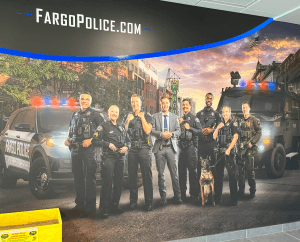Cold Zones Aren’t

“We train with our partners at Tucson police to respond to active shooter incidents. We don’t train to be a part of them.”
–Tucson Fire Department Chief Charles Ryan, quoted by Amaris Encinas and Perry Vandell in “Tucson officer shoots man suspected of ambushing first responders and neighbors, killing 1” in AZCentral.com, 19 July 2021
Let’s start with an example of a “Cold” zone that heated up.
The Glendo Dump Road: Cold –> Warm
One morning in the summer of 1994, I woke from a sound sleep to find a woman with long, straight dark hair and enormous brown eyes standing near me. Not my wife. Todd’s wife? Yes, Todd’s wife. What does she want?
“George, wake up. There’s been an accident on the dump road. Todd’s rolling over there now.”
I was working nights as a law enforcement park ranger at Glendo State Park, Wyoming.
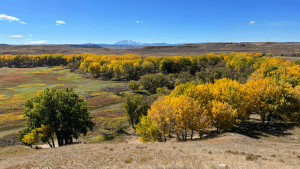
Because Glendo was 111 miles north of our home in Cheyenne, I worked my four “10”-hour shifts (actually, about a 10, a 14, a 17, and a 3 or 4) Thursday through Sunday, sleeping during the day in the basement of Platte County Deputy Todd Dimond. Monday morning, on my way back to Cheyenne, I’d drop off the weekend’s citations and other reports at the county courthouse in Wheatland (we “pressed hard to make five copies” in those un-automated days).
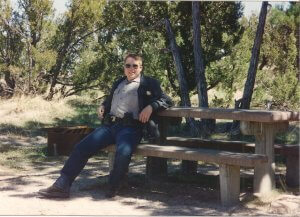
On my off-time, I worked with the Glendo Volunteer Ambulance. About 210 people lived in the tiny town of Glendo, Wyoming, just outside the park. They survived by selling bait and gas and repairing boat motors for park visitors. I was an EMT by virtue of my Weekend Warrior gig as an Aeromedical Evacuation Crew Member on Wyoming Air National Guard C-130s.
I was dispatched to an auto accident, so I grabbed my EMT jump bag and rolled out the door as fast as I could.
I left behind the Kevlar vest I wore at night as a park ranger.
I also left my duty belt on the dresser.
Todd had a head start on me, but I didn’t have as far to go. I caught up with him by the turn onto the dump road, and I followed the trail of dust he was churning up with his police package Taurus. Deputy Dimond pulled up next to a full-sized van that was off to the side of the road. It was leaning into a ditch, but it had not rolled onto its side. A man who looked to be in his late 30s or early 40s was staggering around by the van.
I was trying to figure out the mechanism of injury. The van didn’t look like it had hit anything. Maybe the damage was on the other side?
The injured man was facing away from me. Todd ran up in front of him and sat the man down. As I approached, I could see Todd’s face over the man’s shoulder. Todd looked confused. He pulled open the man’s jacket. Todd’s eyes grew wide.
“George,” Todd said, “This man’s been STABBED.”
He had.
Like, 17 times, with a screwdriver it turned out, in the chest and abdomen. One of the chest wounds appeared to be bubbling a little.
As I dressed the man’s bubbly wound with an occlusive dressing, and did my best to patch up the other holes as well, he described his assailant. Thankfully, he wasn’t having much difficulty breathing. Seems he and a nephew had been fighting over the attentions of a woman in Glendo’s only bar the night before. Blood is thicker than water, but apparently it wasn’t thick enough to keep his nephew from whipping out a screwdriver and going to town on his torso. Last he’d known, the nephew was sleeping it off in a nearby construction yard (there are only two seasons in Wyoming: Winter, and Road Construction).
Glendo’s rusty, dusty old ambulance arrived to take him to the nearest hospital, which was in Douglas. Sometimes when the volunteer ambulance got called out I would ride in the back with the patient, but as there was a felon at large in the vicinity, I transferred care to others equally capable and put on my Wyoming Peace Officer hat instead. Time was of the essence, so even though I had no Kevlar vest and no duty belt, Todd and I went VFR-direct to the construction yard to hunt for the assailant. Todd loaned me the Mossberg 12 gauge he kept in the electric locking rack of his Platte County Taurus.
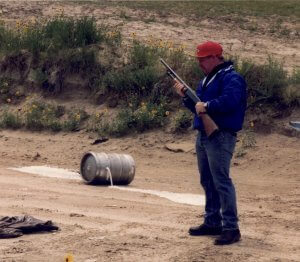
The story of that manhunt, or my small part in it, is told in The Myth of the Racking Sound. The lesson for our purposes here is,
even a purely medical situation can turn tactical in a hurry.
Another lesson I learned early on was, calls never turn out exactly the way they’re dispatched.
Cold, Warm, and Hot Zones
When we teach Tactical Emergency Casualty Care, Tactical Combat Casualty Care, and Public Safety Integration (Rescue Taskforce) classes, we talk about three geographical areas in relation to an active violence incident:
- The Hot zone, where the bad stuff is happening. That would be where the shots and screams are. It was near the finish line at the Boston Marathon, where the bombs were going off.
- The Warm zone. This could be where the killer has been, or just around the corner from where he is. By definition, nothing bad is happening in the warm zone (right now), but we may need to get rescue crews in there, escorted by LEOs in case the bad guy doubles back.
- The Cold zone. This is where the ambulances are staging, well away and out of the direct line of fire of the bad guy.
Care Under Fire / Direct Threat
In the Hot zone, we follow Care Under Fire or Direct Threat protocols. There isn’t much, medically, we can do while taking fire. We can throw on a tourniquet, because if we wait till after the smoke clears, it may be too late to keep a gusher from bleeding our partner (or us) dry.
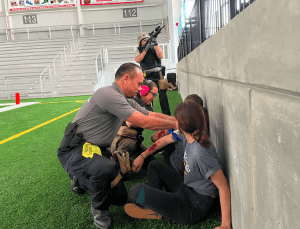
If we’re behind cover, we might roll an unconscious partner into the Recovery Position to protect their airway.
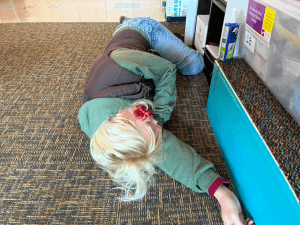
But that’s pretty much it, medically. In the Hot zone,
“The Best Tactical Medicine is Return Fire.”
Indirect Threat Care
In the Warm zone, Indirect Threat protocols allow us to do a little more, medically. Mainly, we worry about establishing hemostasis (keeping the person from bleeding out). That might involve direct pressure, packing a junctional wound, and maybe even applying a pressure dressing over the packing to free up our hands.
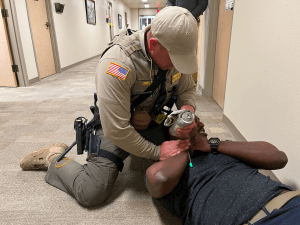
Evacuation Care
In the Cold zone, we can do just about any medical intervention we would normally do, if there wasn’t an active shooter three blocks away. Although patients are usually evacuated from the Warm zone to the Cold zone, and then to the hospital, Evacuation Care takes place in the Cold zone.
Unfortunately, Warm and even Cold zones can heat up. On a dime.
Columbine: Warm –> Hot
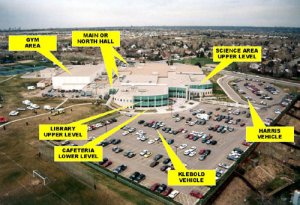
Before entering the high school, the Columbine killers shot some kids outside by the sidewalk (below and to the left of the closest part of the school in this photo). Because the killers had tossed nearly 100 IEDs, it took SWAT nearly 3 hours to clear the entire facility. Meanwhile, kids were bleeding onto the grass outside.
Deeming the fields around the school to be Warm zones, firefighters attempted to rescue the wounded, only to come under fire from the school. While the killer’s marksmanship was sub-mediocre (said it before, and I’ll say it again: these payasos who shoot up schools are NOT Navy SEALs), the lesson was plain to see: Warm zones can become Hot. Just like that. Here’s another example:
Burnsville, MN: Warm — > Hot
After midnight on the early morning of Sunday, 18 Feb 2024, officers spent over three hours in a house, trying to negotiate a man’s surrender. When they had come to arrest him for sexual assault, he had barricaded himself with seven children and adolescent minors (five his). The perp had a history of violent offenses and was a prohibited possessor (unable to lawfully purchase or own firearms) owing to a 2008 conviction for headbutting his girlfriend, pushing her down stairs, and assaulting her with a knife. This charming ladies’ man had no trouble finding more female companionship, including one who bought him several guns.
Disregarding the safety of his own children, he opened fire on the officers with at least one AR, wounding police Sgt Adam Meldicott, officer Matthew Ruge, and officer Paul Elmstrand. Officers managed to CasEvac some of the wounded from the Hot zone inside the house to the Warm zone by the vehicles outside.
Adam Loren Finseth, a firefighter paramedic with Burnsville FD, was a two-tour Iraq veteran attached as a tactical medic to the local SWAT team. Finseth was treating one of officers when the prohibited possessor opened fire from an upstairs window, killing the 40-year-old firefighter. Officers Elmstrand and Ruge also died.
All firefighters expect to go into harm’s way. Tac Medics expect that harm might be in the form of bullets. But even a “BS call” like a minor injury accident can become extremely violent; for example, what happened in Fargo, North Dakota.
Fargo: Cold –> Hot
On 14 July 2023, four officers (two Field Training Officers and two rookies) and several firefighters responded to a minor injury three-car crash in Fargo.
A spree killer en route to attack a crowd saw them. If he could take out four cops in an ambush (a significant percentage of tiny Fargo’s on-duty patrol officers), he would have almost free rein at the county fair or wherever it was he was planning his massacre (there were two “major events” nearby that day). He pulled into a parking lot next to where the crash had taken place, and waited.
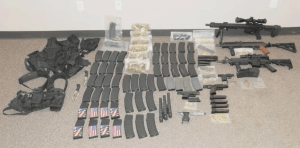
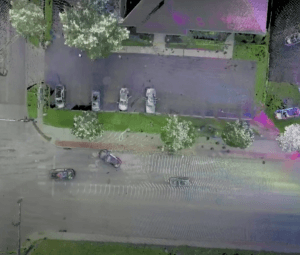
The killer was parked in the rightmost car near the center of the photo (a cop cruiser that responded to the shots fired call in in the far right-hand side of this image). Three of the officers, FTO Andrew Dotas and rookies Jake Wallin and Taylor Hawkes, were in his kill zone, by the tree in the middle (an FTO is a Field Training Officer). The other FTO, Zach Robinson, was near the car parked in the second lane. Not shown in the overhead diagram is the fire engine, which was parked a few lengths behind the car in the street.
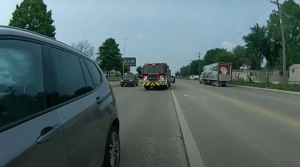
The fire truck was parked in the second southbound lane from the right (between the outside, or westmost, lane and the center turn lane) to protect those working the MVA from traffic approaching from behind (from the north). Traditionally, at MVAs, the greatest danger is from passing cars (mainly, idiot drivers who don’t slow down or get over).
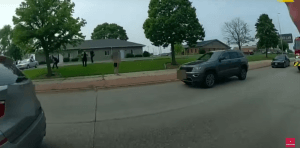
This image, again from Zach Robinson’s BWC but facing west this time, shows the moment the shooting began. The officers had been walking toward a car in the parking lot off camera to the left (southwest), to interview some witnesses who were waiting in a car. The killer’s car was between the witnesses’ and the boys in blue. The killer is sticking a rifle out though the driver’s window of the light-colored sedan in the parking lot at the three FPD officers on the grassy bank between the parking lot and the sidewalk.
Also in the line of fire were the woman standing on the sidewalk, passing cars, and the fire engine on the right-hand side of this image.
Whether the firefighters were directly targeted or not, the fire engine took incoming rounds. The firefighters backed it up as far as possible out of the kill zone. Later, after Zach Robinson had stopped the killer, firefighters returned and rendered aid to the wounded. They saved two of the severely wounded cops, Hawkes and Dotas. Jake Wallin was, sadly, beyond earthly help.

Jake was moving and got a shot off before he went down. Robinson’s response was beyond exemplary. I’m planning a separate article about their extraordinary heroism, and about the other “tactical” aspects of that gun battle. The takeaway for our medical purposes here is,
ALL fire / EMS personnel should have fundamental tactical training.
This should involve movement under fire, cover and concealment, and how to extricate themselves from the KZ, kill zone, of an ambush. It should also involve close range empty hands defense. Even if you are an armed police officer, when a bad guy sticks a gun in your face, your own gun will have zero effect on the outcome if you don’t off-line and control the bad guy’s gun first.
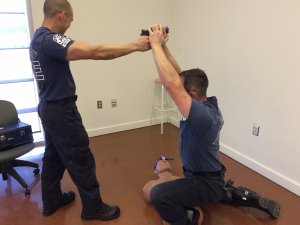
Gone are the days when we could separate “tactical” and “medical.” They never really were mutually exclusive, but now, EMS personnel are being directly targeted. Here’s an example.
The Vistas: Cold –> Hot
On 18 July 2021, a man murdered his girlfriend, Jennifer Fells, and set his house on fire (a large percentage of arsons are set to cover up a crime) in “the Vistas,” a neighborhood in south central Tucson.
A few blocks away he found a pair of EMTs standing by (for another incident) in an AMR (American Medical Response) ambulance. He shot 20-year-old EMT Jacob Dindinger in the head, and EMT Cassandra Romero (who was only a year or two older than Jacob) in the chest and arm.
Returning to his burning home, he found firefighters and neighbors outside it fighting the blaze. He shot and killed a neighbor, Cory Saunders (in front of Saunders’ 11 year old son), grazed another neighbor in the head, and shot a fire chief in the arm.
He was killed in a gunfight with TPD Officer Danny Leon later that afternoon, after ramming Leon’s police car with his SUV.
Young EMT Dindinger later died of his injuries.
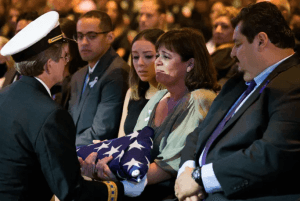
These are not the only instances of medical rescuers being attacked in the line of duty.
It stands to reason that a person who murdered his wife and set his house on fire wants it to burn to the ground. He doesn’t want you interfering with his plans by putting out the fire.
During the 1992 Los Angeles insurrection, over 3700 buildings were burned or looted. Rioters shot at responding fire personnel (60+ people were murdered, and 2300+ injured, in the name of “justice”–and for free Sony TVs). Law enforcement, including the Border Patrol, plus National Guard troops, did what they could to protect the fire / EMS crews, but most of the firefighters were spread thin and poorly protected, especially in the opening days of the riots.
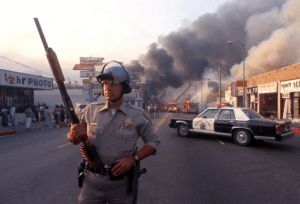
A gang banger who shoots a member of a rival gang probably wants his rival to die. He doesn’t want you saving the guy he shot. His propensity for violence has already been clearly demonstrated.
When we teach Public Safety Integration classes, the EMS folks tend to doze through the Care Under Fire portion of the training. “That won’t ever be us,” they say. “The farthest forward we’ll ever get will be the Warm zone, and even then, only under armed police escort.”
Think again.
And plan accordingly.
–George H, NAEMT TECC / TCCC instructor
The image at the top of this article comes from Global Medical Response on Linkedin.
Most of the information about the Fargo incident comes from an interview I conducted at the Fargo Police Department on 20 Oct 2023, as well as my examination of the scene along 25th Street South at 9th Avenue South, and from Duane Wolf’s excellent article “Incident analysis: Bodycam video shows how heroic North Dakota officer stopped ambush” published in Police1.com on 21 Aug 2023.
